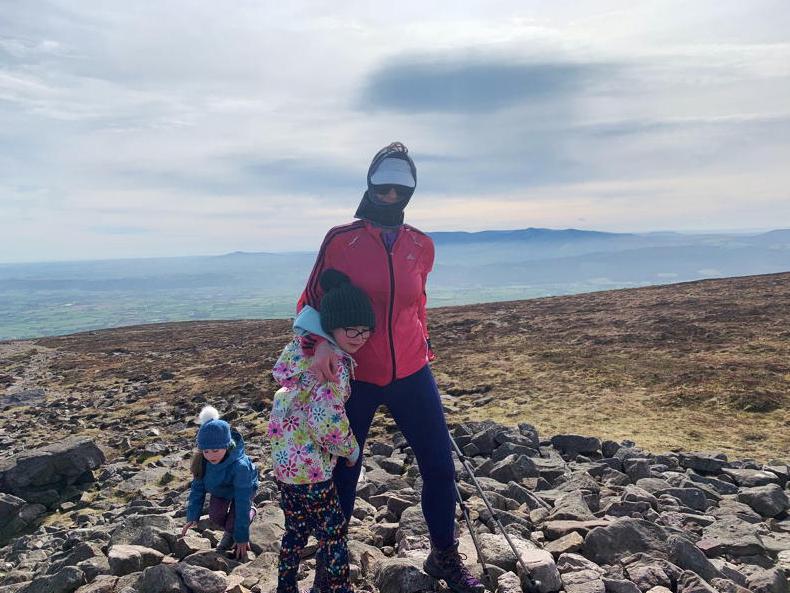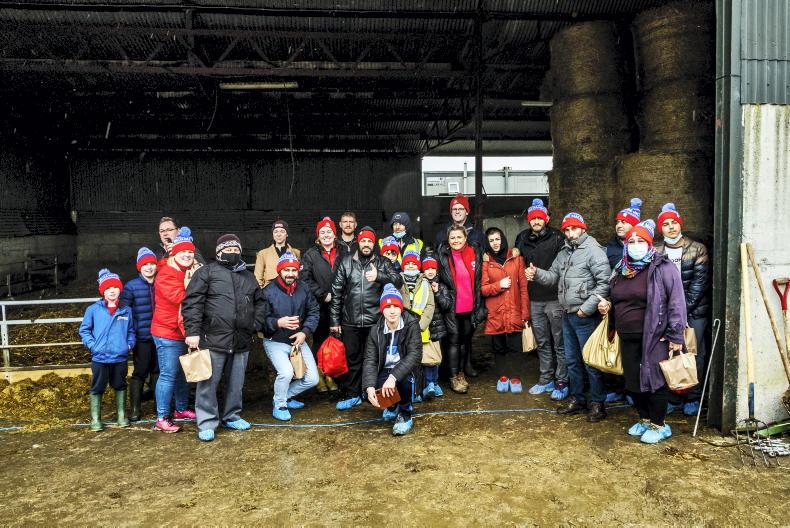“Can we climb Sliabh na mBan on St Patrick’s Day, Mammy?” my smaller daughter asked last week?
Nonchalantly – not willing to commit fully, I replied we could, but asked if she would prefer to go to a parade?
Although slightly perplexed at the options being presented, she pressed for the mountain of the women, keen that her little tradition be maintained.
Being so young, her traditions are still few and far between – COVID-19 made that a reality. Last year on St Patrick’s Day we had no parades or matches to attend, so staying within our 5km zone we climbed Sliabh na mBan for something to do.
That day was the busiest I had ever been on the peak – a new tradition for many perhaps.

Amii, Raine and India McKeever climbing Sive na mBan on St Patrick's Day 2021.
A tradition is the “transmission of customs or beliefs from generation to generation”. St Patrick’s Day is a traditional we all grew up with. We celebrate his feast day every year but it is seldom mentioned that St Patrick was first brought to Ireland as a slave by traffickers. He was effectively an undocumented worker or a refugee.
Together with Macra na Feirme, we were delighted to host a group of Syrian and Afghan refugees living in Ballaghaderreen last month on the Irish Farmers Journal farm in Tullamore.

Visitors on Tullamore Farm. \ Philip Doyle
It was evident from speaking with the children that what separates us in youth and innocence is minor. Thirteen-year-old Mohammad told me that he is learning Gaelic football and although it is hard, he is learning fast. He is here now and his traditions will combine with those of his new home.
However, for the children’s parents who have left behind their lives and traditions, suffering from their recollection and reminiscence is a sad reality. Having to leave our country, through no wish of our own, is something that we as a people can relate to from our history. This history is preserved in our traditions, memories and also our built environment. Ciara recently visited room 112 in the Shelbourne Hotel – the room in which the Irish Free State Constitution was drafted 100 years ago.
At that time our capital city still lay in ruins, like many across Europe. The rebuilding after the Rising was not completed for decades. Given our shared history in Europe, it is hard to accept that within a few short weeks of that visit to Tullamore Farm, images of bombed buildings would again be evident across all media. And Europe would be facing a refugee crisis of an unprecedented scale as Ukrainian cites are shelled by their neighbour.
A tradition, for which Irish people are well known is their generosity in supporting fundraising initiatives.
Although the families that visited Tullamore Farm were programme refugees and would be moving to housing as soon as feasible, Mohammad and his family of six have been living in what is effectively a converted hotel for 15 months.

Direct provision, the accommodation provided for non-programme refugees, is never spoken of in a positive light. We also have a well-flagged housing crisis and yet the Irish Red Cross portal crashed, with the volume of people pledging to accommodate Ukrainian refugees that arrive in Ireland.
Back to Sliabh na mBan, while my daughter’s request belies her struggle to the top of the 721m trek, I am happy to oblige with this new tradition to help solidify a positive memory from COVID-19 in her small head. The parade, she says, we can watch on the telly.
Read more
Hope is not a strategy when it comes to our most basic need – food!
Feeling a fraud and selfish in the face of human suffering
“Can we climb Sliabh na mBan on St Patrick’s Day, Mammy?” my smaller daughter asked last week?
Nonchalantly – not willing to commit fully, I replied we could, but asked if she would prefer to go to a parade?
Although slightly perplexed at the options being presented, she pressed for the mountain of the women, keen that her little tradition be maintained.
Being so young, her traditions are still few and far between – COVID-19 made that a reality. Last year on St Patrick’s Day we had no parades or matches to attend, so staying within our 5km zone we climbed Sliabh na mBan for something to do.
That day was the busiest I had ever been on the peak – a new tradition for many perhaps.

Amii, Raine and India McKeever climbing Sive na mBan on St Patrick's Day 2021.
A tradition is the “transmission of customs or beliefs from generation to generation”. St Patrick’s Day is a traditional we all grew up with. We celebrate his feast day every year but it is seldom mentioned that St Patrick was first brought to Ireland as a slave by traffickers. He was effectively an undocumented worker or a refugee.
Together with Macra na Feirme, we were delighted to host a group of Syrian and Afghan refugees living in Ballaghaderreen last month on the Irish Farmers Journal farm in Tullamore.

Visitors on Tullamore Farm. \ Philip Doyle
It was evident from speaking with the children that what separates us in youth and innocence is minor. Thirteen-year-old Mohammad told me that he is learning Gaelic football and although it is hard, he is learning fast. He is here now and his traditions will combine with those of his new home.
However, for the children’s parents who have left behind their lives and traditions, suffering from their recollection and reminiscence is a sad reality. Having to leave our country, through no wish of our own, is something that we as a people can relate to from our history. This history is preserved in our traditions, memories and also our built environment. Ciara recently visited room 112 in the Shelbourne Hotel – the room in which the Irish Free State Constitution was drafted 100 years ago.
At that time our capital city still lay in ruins, like many across Europe. The rebuilding after the Rising was not completed for decades. Given our shared history in Europe, it is hard to accept that within a few short weeks of that visit to Tullamore Farm, images of bombed buildings would again be evident across all media. And Europe would be facing a refugee crisis of an unprecedented scale as Ukrainian cites are shelled by their neighbour.
A tradition, for which Irish people are well known is their generosity in supporting fundraising initiatives.
Although the families that visited Tullamore Farm were programme refugees and would be moving to housing as soon as feasible, Mohammad and his family of six have been living in what is effectively a converted hotel for 15 months.

Direct provision, the accommodation provided for non-programme refugees, is never spoken of in a positive light. We also have a well-flagged housing crisis and yet the Irish Red Cross portal crashed, with the volume of people pledging to accommodate Ukrainian refugees that arrive in Ireland.
Back to Sliabh na mBan, while my daughter’s request belies her struggle to the top of the 721m trek, I am happy to oblige with this new tradition to help solidify a positive memory from COVID-19 in her small head. The parade, she says, we can watch on the telly.
Read more
Hope is not a strategy when it comes to our most basic need – food!
Feeling a fraud and selfish in the face of human suffering









 This is a subscriber-only article
This is a subscriber-only article











SHARING OPTIONS: